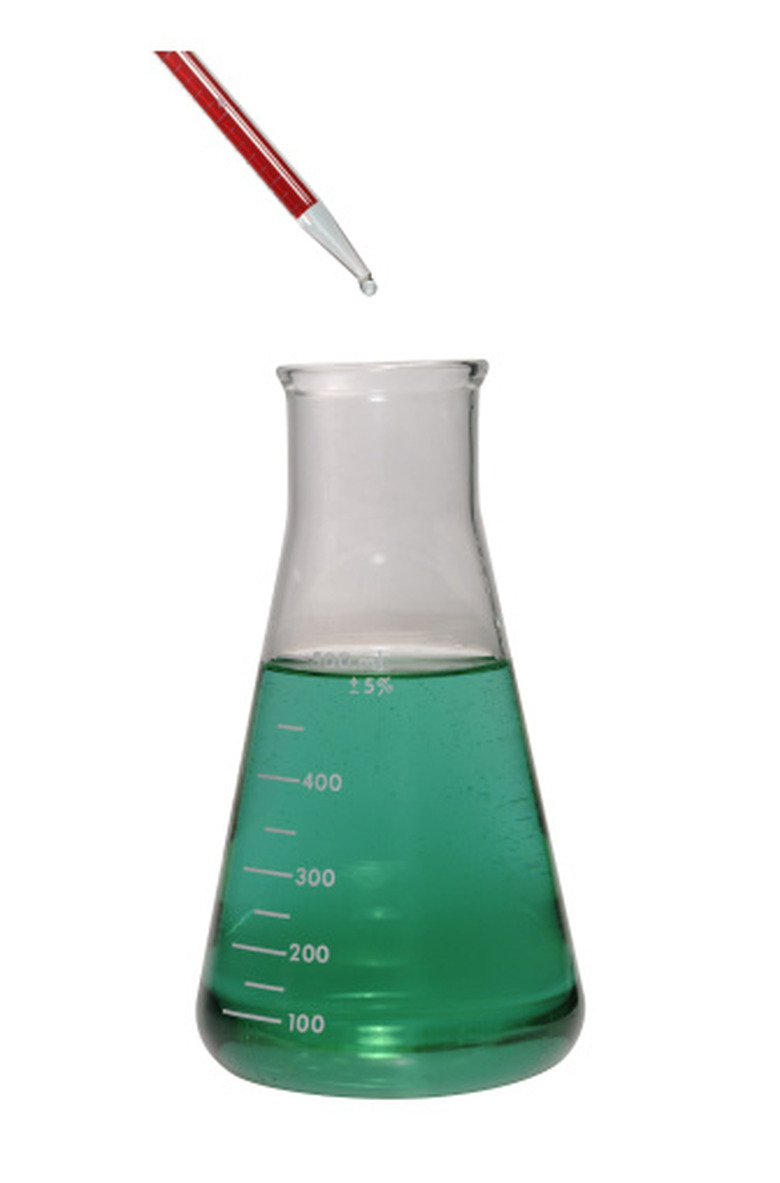How To Calculate The Grams Of Reactants In A Product
Chemical reactions convert reactants into products, but, typically, there are always some amounts of reactants left in the products of the reaction. The reactants remaining unused in the products decrease the purity of the reaction yield. Determining the expected yield of a reaction includes determining which reactant is the limiting reactant for the equation. Any amount of the other reactants beyond that needed to meet the requirements of the chemical equation will remain in the products. The units of measure for reactants that don't react is moles. To increase the purity of the product you must know how much of the reactants to eliminate by weight.
Step 1
List the reactants for the chemical reaction of interest. These are the possible reactants remaining in the product after the reaction is complete.
Step 2
Calculate the molecular weight of all the reactants. Add together the atomic weight of each atom in each reactant. For example, for the chemical reaction that involves CaCO3 and HCl, calculate the molecular weight of both reactants. The molecular weight of HCl is equal to the addition of the atomic weights of hydrogen and the atomic weight of chlorine, resulting in 1.008 + 35.453 = 36.461 g/mol. The molecular weight of CaCO3 is equal to the addition of the atomic weights of calcium, carbon and three times the atomic weight of oxygen, resulting in 40.078 + 12.011 + 3 * 15.999 = 100.086 g/mol.
Step 3
Determine the mole ratio for each reactant. The mole ratio specifies how many moles of one reactant are required for the reaction to go to completion. Continuing the example, what is the mole ratio for CaCO3 and HCl in the equation: CaCO3 + 2 HCl –> CaCl2 + CO2 + H20. The mole ratio for CaCO3 is 1 mole CaCO3 requires 2 moles of HCl, therefore, the ratio is 1-to-2. For HCl, 1 mole of HCl requires 1/2 mole of CaCO3 for complete reaction, therefore, the ratio for HCl is 1-to-1/2.
Step 4
Determine the limiting reagent for the reaction. The limiting reactant of the equation is the reactant completely used during the reaction. Using the mole ratio and starting amounts of the reactants, you can find which reactant is the limiting reactant. Continuing the example, assume that the reaction begins with 30.027 grams of CaCO3 and 10.938 grams of HCl. Convert these values to moles by dividing by their molecular weights. There are 0.300 moles of CaCO3 and 0.478 moles of HCl. According to the mole ratio for CaCO3, 0.300 grams of CaCO3 would require 0.600 grams of HCl to react completely. Therefore, HCl is the limiting reactant.
Step 5
Subtract the amount of each reactant from the starting amount to find the amount of the reagents in excess of needs. Using the mole ratio for HCl, 0.478 moles of HCL require 0.239 moles of CaCO3 for complete reaction. The amount of CaCO3 in excess is starting amount minus ending amount. Amount of CaCO3 in product is 0.300 – 0.239 = 0.061 moles of CaCO3.
Step 6
Convert the amount of each reactant excess into grams using its molecular weight. Weight is equal to molecular weight multiplied by the number of moles. CaCO3 is the only excess reactant in this example, so the amount of CaCO3 is 100.089 * 0.061 = 6.105 grams.
Things Needed
- Periodic table
- Balanced chemical reaction
- Calculator
Cite This Article
MLA
Lancaster, Sean. "How To Calculate The Grams Of Reactants In A Product" sciencing.com, https://www.sciencing.com/calculate-grams-reactants-product-8414542/. 24 April 2017.
APA
Lancaster, Sean. (2017, April 24). How To Calculate The Grams Of Reactants In A Product. sciencing.com. Retrieved from https://www.sciencing.com/calculate-grams-reactants-product-8414542/
Chicago
Lancaster, Sean. How To Calculate The Grams Of Reactants In A Product last modified August 30, 2022. https://www.sciencing.com/calculate-grams-reactants-product-8414542/
